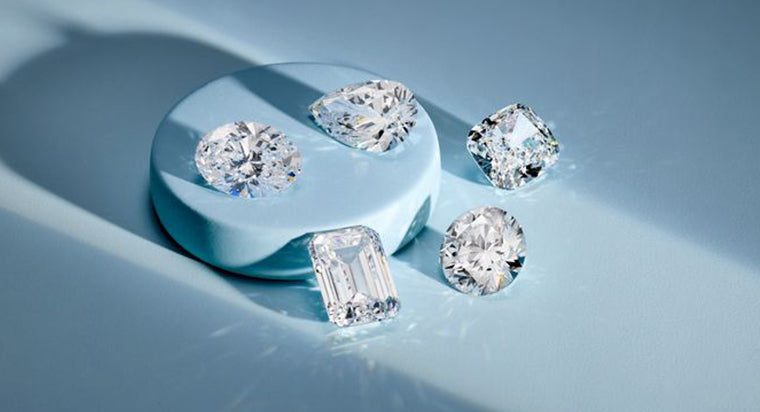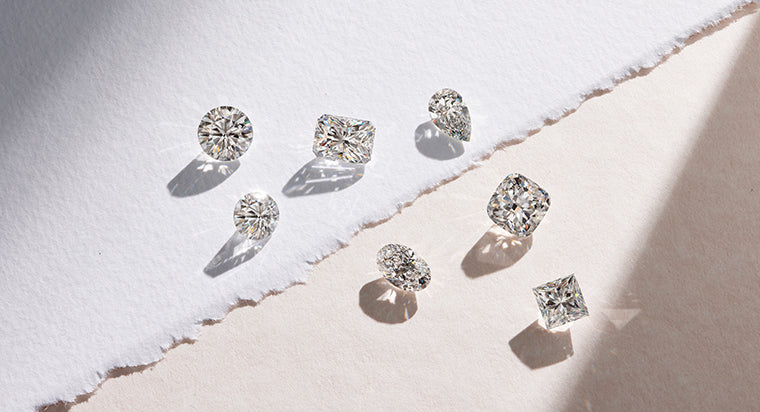What You Need to Know About VVS Clarity Diamonds and How They'll Actually Look In Person

Learning the lingo is probably one of the most difficult — and confusing — parts of buying a diamond engagement ring.
There are so many vital things you need to know before making an investment, like the 4Cs of diamonds and what they mean. One of the 4Cs, clarity, is one of the most important to think about, though we tend to ignore it until later on in the buying process while paying attention to larger concerns, like carat and cut.
Diamond clarity refers to how the stone sparkles and looks under light. Moreover how it's graded on a scale that measures how many visible flaws (called diamond inclusions) it has, and how severely these flaws affect the brilliance of the stone. This scale — ranging from absolutely no inclusions (Flawless) to many inclusions (Included) — determines how beautiful your diamond will look to the naked eye.
VVS is one of the terms you'll come across when shopping for a diamond engagement ring, but what does that mean — and is it a good choice?
TABLE OF CONTENTS
What are VVS Diamonds?
VVS diamonds sit under Flawless and Internally Flawless diamonds on the clarity scale.
VVS means the diamond has tiny imperfections in the diamond that are very difficult to identify even with 10x magnification — and they're almost impossible to see without magnification. (For the record, some types of inclusions are “better” to have than others, as they don't affect the sparkle of your stone nearly as much as other types. So a diamond having some inclusions is absolutely not a dealbreaker and in no way means those flaws will definitely bring down the brilliance.)
The VVS clarity range is broken down into two subclasses: VVS1 and VVS2
VVS1 vs VVS2: What's the Difference Between VVS1 and VVS2 Diamonds?
Though they're both beautiful diamonds, VVS1 diamonds have fewer inclusions in number, size and location than VVS2 diamonds.
The size of the inclusions in VVS1 stones tend to be tiny and microscopic, the location tend to be off center in VVS1 and closer under the table facet in VVS2. The number of inclusions in VVS diamonds can vary from single inclusion or multiple. VVS1 diamonds typically only have one or two inclusions at the most.
And, yes, the placement of inclusions is important enough to bump a diamond out of the VVS1 range. Inclusions off to the side of your stone can often be hidden with prongs. So once the stone is placed in your engagement ring setting it's as if the flaw isn't there at all. But there's nothing that can hide an inclusion that's right in the center of your stone.

How is a VVS Diamond Graded?
Certified diamond experts evaluate diamonds based on a number of qualifications. Diamond clarity specifically is graded under specialized microscopes that can help them spot any inclusions that affect the overall clarity of the stone.
Tweezers are used to hold the diamond from girdle to girdle and magnification is adjusted so that the grader can view the diamond. The grader also uses the standard loupe and 10X magnification to ensure that the inclusions are viewed under different lenses and accurately recorded. And that's important to remember. Any inclusions you see on the GIA grading report have been spotted under this extreme magnification — a way you'll probably never look at your own diamond once it's in a ring.
Any inclusions found in the diamond are graded based on a variety of factors, including size, number and position on the diamond. They also look at whether the inclusion is external or internal within the diamond, along with the color of the inclusions. All of these factors affect the grade of the diamond in the order mentioned. Even if a diamond has several inclusions, if they are not eye-visible a diamond may still be graded as VVS.
All laboratories are also easily able to determine if clarity has been altered with laser drilling or treatments to the diamond. All reputable retailers disclose this information when selling diamonds. With Clarity does not carry any altered or fake diamonds (we carry lab-made diamonds, but that's another subject altogether).
How to Choose a Diamond
Clarity is one of the major 4 C's of diamond buying, in addition, to cut, color, and carat.
Watch our company founder help you assess which combination of the 4 C's will yield in the best diamond for your budget.
How much do VVS Diamonds Cost?
VVS diamonds hit a sweet spot in pricing, meaning that you'll pay a lot less than you would for flawless or internally flawless diamonds, but you'll still have a stone that looks virtually identical to FL or IF diamonds.
Even better: The value of VVS diamonds appreciates over time. Actually, the sheer value of VVS clarity diamonds has appreciated higher than IF and FL diamonds over the last five to 10 years.
Of course the actual price of your VVS diamond will depend on whether you're looking at a VVS1 or VVS2 diamond, as well as where the diamond is graded based on the other 3Cs. But if you want to see prices on actual natural diamonds in this clarity grade, you can browse our VVS clarity diamonds here.
Where to Buy a VVS Diamond
When it comes to buying a VVS diamond, we have some good news that's also a bit of bad news.
Let us explain: VVS diamonds are some of the most popular choices for engagement rings and other diamond-centered jewelry, like earrings and necklaces. Their popularity means that nearly every jeweler will have them for sale — the good jewelers, and the not-so-ethical ones.
How can you avoid buying a VVS diamond from one of those unscrupulous jewelers?
Easy: Only buy from a retailer who can provide an authentic certification for your diamond from a reputable lab, like the Gemological Institute of America (GIA) or the International Gemological Institute (IGI).
The GIA is the most widely accepted and respected certification for diamonds, so it's always better to err on the side of caution and buy one with a GIA certificate, which you should always be able to view before you make a payment. With Clarity has access to every GIA-certified diamond on the market, meaning you know the diamond you buy is legit, and you can access every diamond's certification through its listing page.
The International Gemological Institute is an independant laboratory that was established back in 1975, and headquarters all over the world. IGI researches and authenticates colored stones and jewelry, along with lab grown diamonds (including With Clarity lab diamonds). Regarding assessments and certification, IGI uses the same letter grading system like GIA. That said, for clarity IGI also grades gems as “I” (included) to “FL” (flawless). So are VVS lab diamonds different from VVS natural diamonds? No, inclusions form the same way in natural diamonds and lab created diamonds. More about IGI Certification.
(And if you're not quite sure about anything you're looking at, our expert gemologists are standing by to help you out.)
FAQs
What is the difference between vvs clarity and vs clarity?
Is there a big price difference between vvs and vs clarity diamonds?
What are the types of inclusions in a vvs diamond?
What are the differences between a vvs1 and vvs2 diamond?









